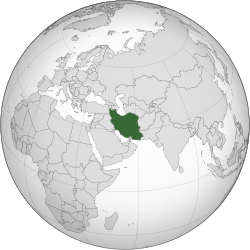
Back Џьамтәыла Abkhazian Iran ACE Иран ADY Iran Afrikaans Iran ALS ፋርስ Amharic Iran AMI Irán AN Persealand ANG ईरान ANP
Islamic Republic of Iran | |
|---|---|
| Motto: استقلال، آزادی، جمهوری اسلامی Esteghlāl, Āzādi, Jomhuri-ye Eslāmi | |
| Anthem: سرود ملی جمهوری اسلامی ایران Sorud-e Melli-ye Jomhuri-ye Eslāmi-ye Irān ("National Anthem of the Islamic Republic of Iran") | |
 | |
| Capital and largest city | Tehran 35°41′N 51°25′E / 35.683°N 51.417°E |
| Official languages | Persian |
| Recognised regional languages | |
| Ethnic groups | List of ethnicities
|
| Religion | Shia Islam (official)[4] |
| Demonym(s) |
|
| Government | Unitary theocratic presidential Islamic republic |
| Ali Khamenei | |
| Mohammad Mokhber (acting) | |
| Mohammad Mokhber | |
| Mohammad Bagher Ghalibaf | |
| Gholam-Hossein Mohseni-Eje'i | |
| Legislature | Islamic Consultative Assembly |
| Establishment history | |
| c. 678 BC | |
| 550 BC | |
| 247 BC | |
| 224 AD[5] | |
| 934 | |
| 1501[6] | |
| 1736 | |
| 1751 | |
| 1796 | |
| 15 December 1925 | |
| 11 February 1979 | |
| 3 December 1979 | |
| 28 July 1989 | |
| Area | |
• Total | 1,648,195 km2 (636,372 sq mi) (17th) |
• Water (%) | 1.63 (as of 2015)[7] |
| Population | |
• 2019 estimate | |
• Density | 48/km2 (124.3/sq mi) (162nd) |
| GDP (PPP) | 2022 estimate |
• Total | |
• Per capita | |
| GDP (nominal) | 2022 estimate |
• Total | |
• Per capita | |
| Gini (2018) | medium |
| HDI (2019) | high · 70th |
| Currency | Iranian rial (ریال) (IRR) |
| Time zone | UTC+3:30 (IRST) |
• Summer (DST) | UTC+4:30 (IRDT) |
| Date format | yyyy/mm/dd (SH) |
| Driving side | right |
| Calling code | +98 |
| ISO 3166 code | IR |
| Internet TLD | |

Iran, officially the Islamic Republic of Iran, also known as Persia, is a country in Western Asia. It is part of the Middle East region. It shares borders with Afghanistan, Armenia, Azerbaijan, Iraq, Pakistan, Turkey, and Turkmenistan.
Tehran is the capital and largest city. Iran is the eighteenth largest country in the world. It has more than 84.9 million people. Iran has been a member of the United Nations since 1945. It is a member of the Organization of the Petroleum Exporting Countries (OPEC).[12] It is an Islamic republic.
Iran is a powerful country in the region. It has a lot of natural gas and oil, which is important for its economy. It's also a significant place because it's where Shia Islam is most important. The country's economy is big, and it's a member of many important groups like the United Nations.
Iran has a long history and a rich culture. That's why it has many special places that are recognized by the United Nations. It's also famous for its cultural traditions, like music and dance. In 2019, many people visited Iran, making it one of the fastest-growing tourist destinations in the world.
- ↑ Jeroen Temperman (2010). State-Religion Relationships and Human Rights Law: Towards a Right to Religiously Neutral Governance. Brill. pp. 87–. ISBN 978-90-04-18148-9. Archived from the original on 2022-12-18. Retrieved 2022-02-23.
The official motto of Iran is Takbir ('God is the Greatest' or 'God is Great'). Transliteration Allahu Akbar. As referred to in art. 18 of the constitution of Iran (1979). The de facto motto however is: 'Independence, freedom, the Islamic Republic.'
- ↑ "Iran - Languages". Encyclopædia Britannica. Archived from the original on 5 May 2020. Retrieved 9 January 2020.
- ↑ 3.0 3.1 Cite error: The named reference
ciawas used but no text was provided for refs named (see the help page). - ↑ "Iran".
- ↑ Sarkhosh Curtis, Vesta; Stewart, Sarah (2005), Birth of the Persian Empire: The Idea of Iran, London: I.B. Tauris, p. 108, ISBN 978-1-84511-062-8, archived from the original on 2022-12-18, retrieved 2022-02-23,
Similarly the collapse of Sassanian Eranshahr in AD 650 did not end Iranians' national idea. The name 'Iran' disappeared from official records of the Saffarids, Samanids, Buyids, Saljuqs and their successor. But one unofficially used the name Iran, Eranshahr, and similar national designations, particularly Mamalek-e Iran or 'Iranian lands', which exactly translated the old Avestan term Ariyanam Daihunam. On the other hand, when the Safavids (not Reza Shah, as is popularly assumed) revived a national state officially known as Iran, bureaucratic usage in the Ottoman empire and even Iran itself could still refer to it by other descriptive and traditional appellations.
- ↑ Cite error: The named reference
Andrew J. Newman 2006was used but no text was provided for refs named (see the help page). - ↑ "Surface water and surface water change". Organisation for Economic Co-operation and Development (OECD). Archived from the original on 24 March 2021. Retrieved 11 October 2020.
- ↑ "دادهها و اطلاعات آماری". amar.org.ir. Archived from the original on 14 March 2018. Retrieved 13 September 2017.
- ↑ 9.0 9.1 9.2 9.3 "World Economic Outlook Database, October 2021". IMF.org. International Monetary Fund. Archived from the original on 22 January 2022. Retrieved 4 October 2021.
- ↑ "GINI index (World Bank estimate)". World Bank. Archived from the original on 9 February 2015. Retrieved 10 July 2021.
- ↑ Human Development Report 2020 The Next Frontier: Human Development and the Anthropocene (PDF). United Nations Development Programme. 15 December 2020. pp. 343–346. ISBN 978-92-1-126442-5. Archived (PDF) from the original on 15 December 2020. Retrieved 16 December 2020.
- ↑ "United Nations Member States". un.org. 2009-04-30. Archived from the original on 2014-04-12. Retrieved 2022-12-18.
© MMXXIII Rich X Search. We shall prevail. All rights reserved. Rich X Search

